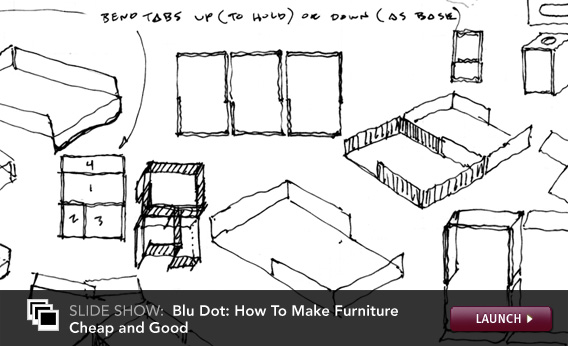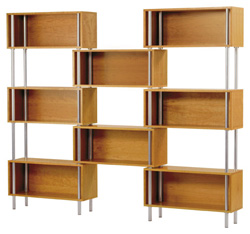John Christakos and Maurice Blanks, Blu Dot
The modernist Minnesota design collective that makes durable, delightful furniture affordable.
When John Christakos, Maurice Blanks, and Charlie Lazor decided to form a design collective in 1997, they were driven by their own desire for beautiful, modern furniture for their first adult homes. The furniture market at that moment was not flush with options. Snooty European retailers made shopping intimidating and sold furniture that was out-of-this-world expensive. IKEA was only a possibility if you happened to live near one of the first American stores. And at more traditional mid-priced outlets like Pottery Barn and Ethan Allen, sleek, modern lines were not the prevailing aesthetic. And so Christakos, Blanks, and Lazor launched a company that sold delightful, durable, modern furniture at a price point that wouldn't break the bank. "We didn't like the stuff we could afford, and we couldn't afford the stuff we liked," says Christakos. "We thought, why don't we try to create a line of furniture that solves this problem?"
Fifteen years later, Blu Dot is still making some of the most imaginative and attractive modern furniture around, at a price point that's still reasonable. (Lazor has since left the company.) Their endurance is especially remarkable given how drastically the landscape of American furniture design has changed since their launch. These days there's an IKEA in every major city. Websites like Hive Modern and Unica Home make high-end European designs more accessible, if not more affordable. Design Within Reach, launched in 1999, has revitalized production of mid-century modern classics. And more recently, low-end retailers like West Elm and CB2 have emerged, selling modern styles rather than traditional ones.
So what sets Blu Dot apart? Designs that are meticulously well-thought-out, well-crafted, and original. The company marries whimsical taste with extreme practicality, which allows them to keep prices low without sacrificing quality. Blu Dot achieves this by staying small (the company currently has 83 employees in the United States) and keeping the design process in-house. (Many rival brands focus on manufacturing or retailing and farm out actual design work to contractors.) This full control of the process, from design to production to retail, allows Blu Dot to learn from any snags or hiccups and use that feedback to improve future products. "Because we control everything," Christakos says, "design all the way through to production, and how things are marketed, and how things are sold—we can still hold true to that ideal of trying to make good design truly accessible, and truly within reach."
Take, for example, the Blu Dot Chicago 8 Box, a shelving unit made of wood veneer boxes and steel poles that feels like a futuristic riff on a mid-century Eames design. Each box can be cut from a single standard-sized sheet of wood, leaving no waste. The space in between boxes is usable shelf space for consumers, but, from a production standpoint, free. It's a beautiful design that was designed to be cheap. "Our design process," says Blanks, "is solving a complex equation with lots of variables. We just go through and look at eight or 10 variables—whether material, machine process, packaging, assembly—and solve each one of those variables. And then when we're done, the residue of that process is the product itself."
Check out the rest of our design Top Right:
Ben Fry, interactive designer
Phillip Lim, fashion designer
Jeanne Gang, architect
Jonathan Ive, Apple product designer




